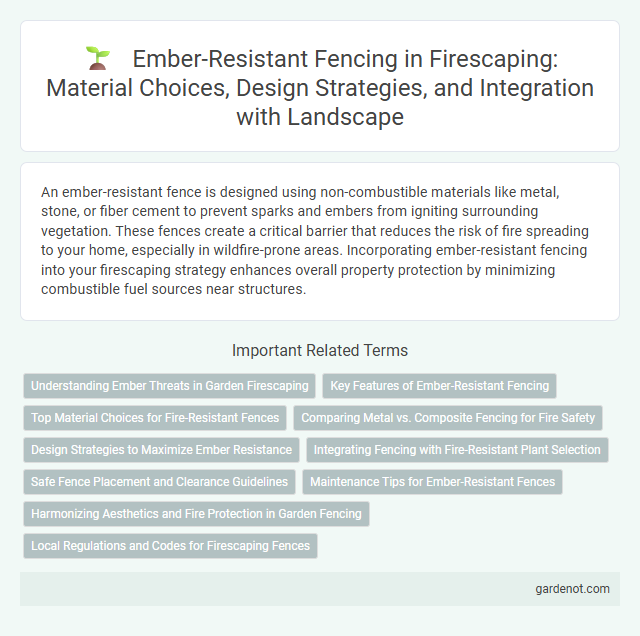An ember-resistant fence is designed using non-combustible materials like metal, stone, or fiber cement to prevent sparks and embers from igniting surrounding vegetation. These fences create a critical barrier that reduces the risk of fire spreading to your home, especially in wildfire-prone areas. Incorporating ember-resistant fencing into your firescaping strategy enhances overall property protection by minimizing combustible fuel sources near structures.
Understanding Ember Threats in Garden Firescaping
Ember-resistant fences play a crucial role in Firescaping by preventing the ignition of garden materials from airborne embers during wildfires. Understanding ember threats involves recognizing that thousands of tiny, burning embers can travel over a mile and ignite combustible vegetation or wooden fences, escalating fire risks. Selecting non-combustible materials like metal or concrete for fencing significantly reduces vulnerability to ember storms in wildfire-prone areas.
Key Features of Ember-Resistant Fencing
Ember-resistant fencing is designed with non-combustible materials such as steel, aluminum, or concrete to prevent ignition from airborne embers during wildfires. Key features include minimal gaps to block ember intrusion, high heat tolerance, and fire-resistant coatings that enhance durability under extreme temperatures. These fences also incorporate mesh screens or solid panels to reduce wind-driven ember penetration, offering enhanced protection around properties in fire-prone areas.
Top Material Choices for Fire-Resistant Fences
Top material choices for ember-resistant fences include metal, fiber cement, and masonry due to their non-combustible properties. Metal fences, such as steel or aluminum, resist burning and withstand high temperatures, effectively blocking embers. Fiber cement and masonry provide durable barriers that do not ignite, reducing the risk of fire spreading through fencing materials.
Comparing Metal vs. Composite Fencing for Fire Safety
Metal fencing outperforms composite fencing in ember resistance due to its non-combustible properties and ability to withstand high temperatures without warping or melting. Composite fences, while durable and aesthetically versatile, contain organic materials that can ignite or degrade when exposed to flying embers during wildfires. Choosing metal fencing significantly enhances fire safety by minimizing ignition risk and providing a reliable barrier against embers in fire-prone areas.
Design Strategies to Maximize Ember Resistance
Design strategies for ember-resistant fences emphasize using non-combustible materials such as metal, masonry, or concrete to prevent ignition from flying embers. Incorporating minimal gaps and tightly fitted panels reduces ember intrusion, while eliminating combustible landscaping features near the fence line further enhances resistance. Proper maintenance, including clearing debris and vegetation, ensures the fence remains an effective barrier against ember-driven wildfire threats.
Integrating Fencing with Fire-Resistant Plant Selection
Ember-resistant fences constructed from non-combustible materials such as metal or fiber cement significantly reduce fire risks by preventing spark ignition near the property boundary. Integrating these fences with strategically chosen fire-resistant plants like succulents, lavender, and rosemary creates a protective landscape barrier that minimizes fuel for wildfires. Proper spacing and maintenance of vegetation alongside ember-resistant fencing further enhance the effectiveness of firescaping in safeguarding homes and communities.
Safe Fence Placement and Clearance Guidelines
Ember-resistant fences made from non-combustible materials like metal or fiber cement significantly reduce fire hazards around properties. Safe fence placement mandates maintaining at least a 10-foot clearance from vegetation and combustible structures to prevent ember ignition. Regularly clearing debris and ensuring unobstructed airflow around the fence enhances its effectiveness as a fire-resistant barrier.
Maintenance Tips for Ember-Resistant Fences
Regular inspection and cleaning of ember-resistant fences prevent the accumulation of debris that can ignite from windborne embers. Use fire-resistant sealants and coatings to maintain the fence's protective barrier and repair any damaged sections promptly to avoid vulnerability. Keeping surrounding vegetation trimmed and clearing dry leaves or flammable materials near the fence further enhances its effectiveness against ember attacks.
Harmonizing Aesthetics and Fire Protection in Garden Fencing
An ember-resistant fence combines fire-resistant materials such as metal or fiber cement with design elements that complement garden aesthetics, ensuring both safety and visual appeal. Incorporating non-combustible vegetation and maintaining clearances around the fence reduces ember ignition risk while preserving the landscape's harmony. Strategic placement and color choices further enhance the fence's integration into garden environments without compromising fire protection.
Local Regulations and Codes for Firescaping Fences
Ember-resistant fences must comply with local regulations and building codes that specify fire-resistant materials and design standards tailored to wildfire-prone areas. These codes often mandate non-combustible or ignition-resistant fencing to reduce ember intrusion and enhance overall property defense. Adherence to local fire department guidelines and community fire safety ordinances is essential for ensuring legal compliance and optimal firescaping effectiveness.
Ember-resistant fence Infographic

 gardenot.com
gardenot.com